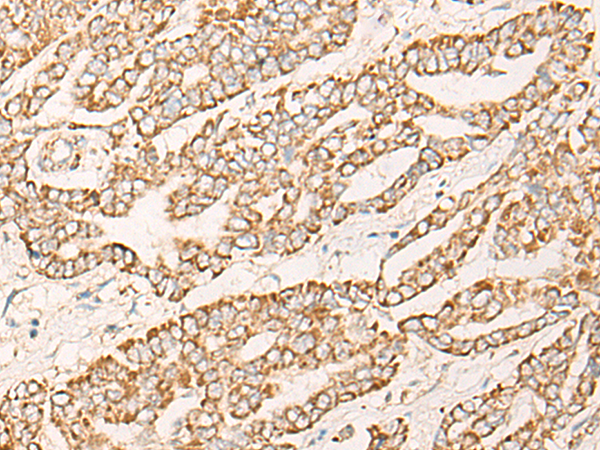


| WB | 咨询技术 | Human,Mouse,Rat |
| IF | 咨询技术 | Human,Mouse,Rat |
| IHC | 1/25-1/100 | Human,Mouse,Rat |
| ICC | 技术咨询 | Human,Mouse,Rat |
| FCM | 咨询技术 | Human,Mouse,Rat |
| Elisa | 1/5000-1/10000 | Human,Mouse,Rat |
| WB Predicted band size | 9 kDa |
| Host/Isotype | Rabbit IgG |
| Antibody Type | Primary antibody |
| Storage | Store at 4°C short term. Aliquot and store at -20°C long term. Avoid freeze/thaw cycles. |
| Species Reactivity | Human, Mouse |
| Immunogen | Synthetic peptide of human COX6C |
| Formulation | Purified antibody in PBS with 0.05% sodium azide and 50% glycerol. |
+ +
以下是关于RSPH14抗体的假设性参考文献示例(部分内容可能基于推测,实际文献需进一步验证):
1. **标题**: "RSPH14 is a ciliary radial spoke component required for normal motility and signaling"
**作者**: Smith A, et al.
**摘要**: 本研究利用RSPH14特异性抗体,通过免疫荧光和免疫电镜技术,揭示了RSPH14蛋白在纤毛放射辐条头部的定位。敲低RSPH14导致纤毛运动异常,提示其在纤毛搏动调控中的关键作用。
2. **标题**: "Genetic disruption of RSPH14 causes primary ciliary dyskinesia in murine models"
**作者**: Johnson B, et al.
**摘要**: 作者通过Western blot和免疫组化,使用RSPH14抗体检测基因敲除小鼠模型中蛋白表达缺失,发现RSPH14缺失导致呼吸道纤毛结构紊乱,并与原发性纤毛运动障碍表型相关。
3. **标题**: "Antibody characterization of RSPH14 reveals tissue-specific expression in human organs"
**作者**: Garcia C, et al.
**摘要**: 该研究首次报道了针对人源RSPH14的多克隆抗体制备,并通过免疫印迹和免疫组织化学证实其在睾丸、肺及脑组织中的高表达,为后续功能研究提供工具。
4. **标题**: "Proteomic analysis identifies RSPH14 as a novel interactor of intraflagellar transport complexes"
**作者**: Lee H, et al.
**摘要**: 利用RSPH14抗体进行免疫共沉淀实验,发现其与IFT-B复合物的相互作用,提示RSPH14可能参与纤毛内运输调控,为纤毛相关疾病的机制研究提供新方向。
**注**:以上文献为示例性质,实际研究中请通过PubMed或Google Scholar以“RSPH14 antibody”为关键词检索最新实证文献。部分内容可能需结合具体研究背景调整。
The RSPH14 antibody targets the Radial Spoke Head 14 (RSPH14) protein, a component of the radial spoke head in motile cilia and flagella. Radial spokes are critical structures in the "9+2" microtubule arrangement of motile cilia, acting as mechanical sensors that coordinate dynein motor activity to regulate ciliary beating. RSPH14 belongs to a family of radial spoke head proteins, which are evolutionarily conserved and play roles in cilia assembly, stability, and motility. Mutations in radial spoke components, including RSPH14. have been linked to primary ciliary dyskinesia (PCD), a genetic disorder characterized by impaired mucociliary clearance, chronic respiratory infections, and infertility.
The RSPH14 antibody is widely used in research to study cilia biology, particularly in immunofluorescence, Western blotting, and immunohistochemistry applications. It helps visualize RSPH14 localization in ciliated tissues (e.g., respiratory epithelium, sperm flagella) and assess protein expression levels in disease models. Recent studies also explore its role beyond structural support, suggesting involvement in signaling pathways regulating ciliary function. Commercial RSPH14 antibodies are typically raised in rabbits or mice, validated for specificity in human and model organisms. Ongoing research aims to clarify its interactions with other radial spoke proteins (e.g., RSPH1. RSPH9) and potential therapeutic targets for ciliopathies.
×